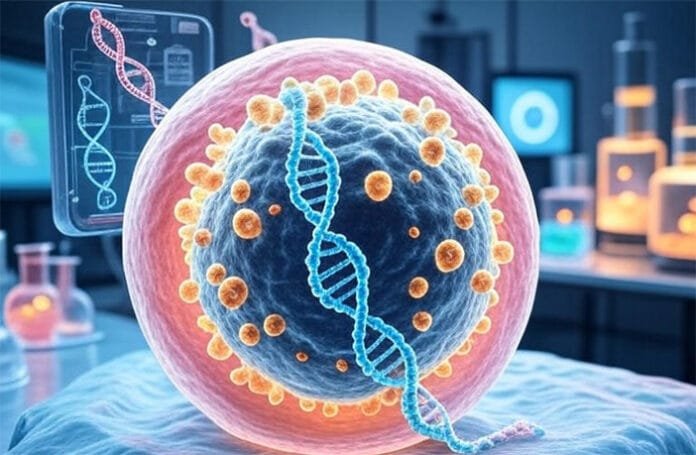A revolutionary leap in HIV treatment has emerged from the labs of Johns Hopkins Medicine, where scientists have demonstrated the potential of gene therapy to deactivate the AIDS virus—potentially for good. This advancement may eliminate the need for daily antiretroviral medication (ART), offering a single-dose future with fewer side effects and a real shot at long-term viral suppression.
What the Study Reveals: Gene Therapy Targets HIV at Its Core
In a landmark study published in Science Advances, researchers introduced a naturally occurring molecule, antisense transcript (AST), into CD4+ T cells, the prime targets of the HIV virus. This molecule is part of HIV’s own genetic architecture and, when amplified through genetic modification, has the capacity to silence the virus’s replication mechanism.
By integrating DNA sequences into T cells to produce high levels of AST, the team managed to induce a dormant state in HIV. The use of GFP (green fluorescent protein) allowed scientists to track viral replication in real time, revealing a dramatic suppression—almost complete inactivation of the virus.
How AST Works: Putting HIV to Sleep at the Genetic Level
The AST molecule acts like a molecular switch. Under normal conditions, HIV replicates relentlessly, gradually breaking down the immune system. However, AST interrupts this replication by interacting with specific viral proteins, causing the virus to enter a latent, non-replicative state.
To fine-tune this interaction, researchers applied laser-assisted analysis and molecular mutations to identify which sections of AST were binding to the virus’s critical proteins. The precision of AST targeting was a key discovery, giving scientists a roadmap for future clinical applications.
Human Cell Testing: Evidence of Real-World Applicability
What elevates this study beyond theoretical research is its application to real human immune cells. Researchers collected samples from 15 HIV-positive individuals and introduced engineered AST into their CD4+ T cells.
The result? A consistent and replicable suppression of viral activity. In every test case, the virus entered a deep latent state, remaining inactive and incapable of reproducing. This is the strongest evidence yet that gene therapy could become a viable treatment pathway for HIV/AIDS.
The Danger of Long-Term ART and the Promise of a One-Time Gene Therapy
Globally, more than 39.9 million people live with HIV, and over 630,000 deaths occur annually, according to the World Health Organization (WHO). Currently, the gold standard for managing HIV is antiretroviral therapy (ART), a daily regimen that successfully controls—but does not cure—the virus.
However, long-term use of ART is not without risks:
Liver toxicity
Metabolic syndrome
Osteopenia and osteoporosis
Drug resistance development
Psychological burden of lifelong medication
The gene therapy model, by contrast, offers potential one-time administration, removing the need for daily pills and their associated risks. This would transform the treatment paradigm, particularly for patients in low-resource settings where medication adherence can be a challenge.
Why This Breakthrough Is Different From Previous HIV “Cure” Hopes
In the past, various therapies have shown promise in reducing viral loads or eliminating infected cells. But relapse has always been a barrier, as latent HIV can hide in “reservoirs” across the body. The AST approach is unique because it leverages the virus’s own genetic code to deactivate it, rather than trying to destroy infected cells.
This strategy:
Reduces viral load without triggering immune hyperactivation
Minimizes mutation-induced resistance
Avoids unnecessary destruction of healthy immune cells
With gene editing tools like CRISPR also gaining ground, the use of endogenous mechanisms like AST might provide a safer, more sustainable solution with lower off-target risks.
Global Implications: Accessibility, Scalability, and Equity
For this approach to shift global health strategies, accessibility is key. The researchers at Johns Hopkins envision scalable platforms for delivering AST-based gene therapy, including:
Lipid nanoparticles
Viral vectors with minimal immune response
Single-shot autologous cell reprogramming
By reducing the reliance on pharmaceutical supply chains and enabling longer treatment intervals, this therapy has the potential to reach millions in underserved populations.
Expert Reactions and Future Directions
Leading infectious disease experts have lauded the discovery as “a monumental step in functional HIV cure research.” The study has attracted attention from international bodies, including NIH, UNAIDS, and several pharmaceutical giants exploring partnerships for clinical trials.
Next steps include:
Animal model testing for safety and efficacy
Phase I/II clinical trials in consenting HIV patients
Development of delivery systems suitable for in vivo use
If successful, regulatory approval and commercial production could follow within 5–7 years, with priority access for high-burden regions.
Looking Ahead: Could HIV Become a Manageable, One-Time Condition?
The dream of a one-time treatment for HIV is no longer theoretical. With this latest gene therapy breakthrough, the future looks increasingly drug-free and sustainable. It’s a shift from management to eradication, where patients may one day receive a single therapy and live without fear of relapse, drug fatigue, or stigma.
The HIV research frontier has just taken a quantum leap, and we may be on the brink of witnessing the decline of daily ART regimens in favor of personalized, gene-targeted cures.
Conclusion: The Dawn of a New Era in HIV Treatment
As the world continues to fight one of the most persistent viral epidemics in modern history, the Johns Hopkins study stands as a defining moment. With its promise of gene-driven viral dormancy, freedom from daily medication, and minimal side effects, this treatment model may soon redefine global HIV care.
We are entering an era where scientific ingenuity meets real-world impact, delivering a future where HIV is no longer a life sentence, but a condition that can be silenced—possibly forever.















